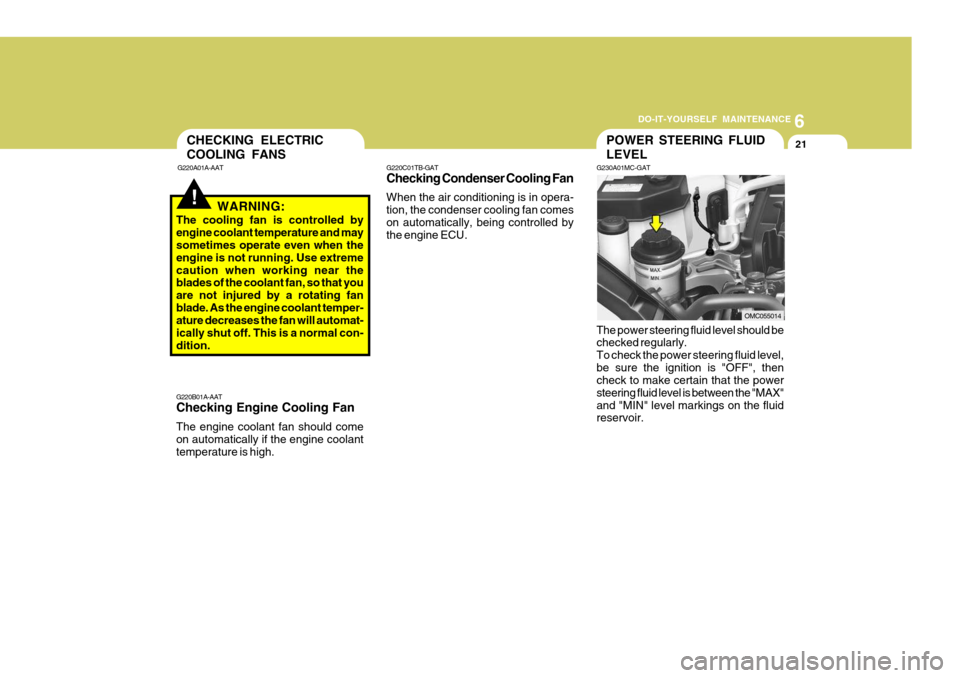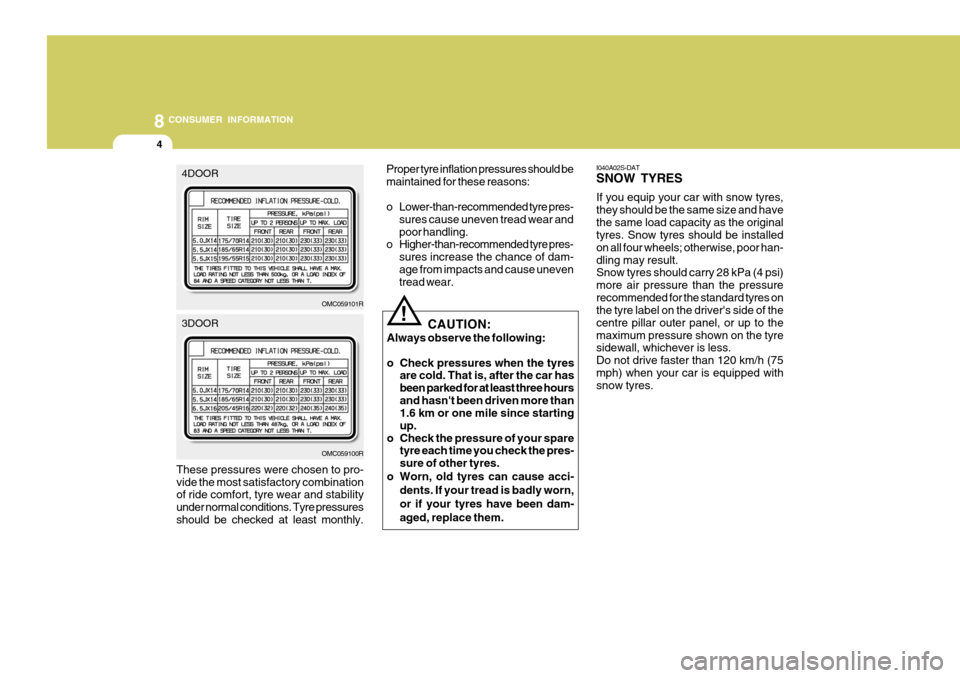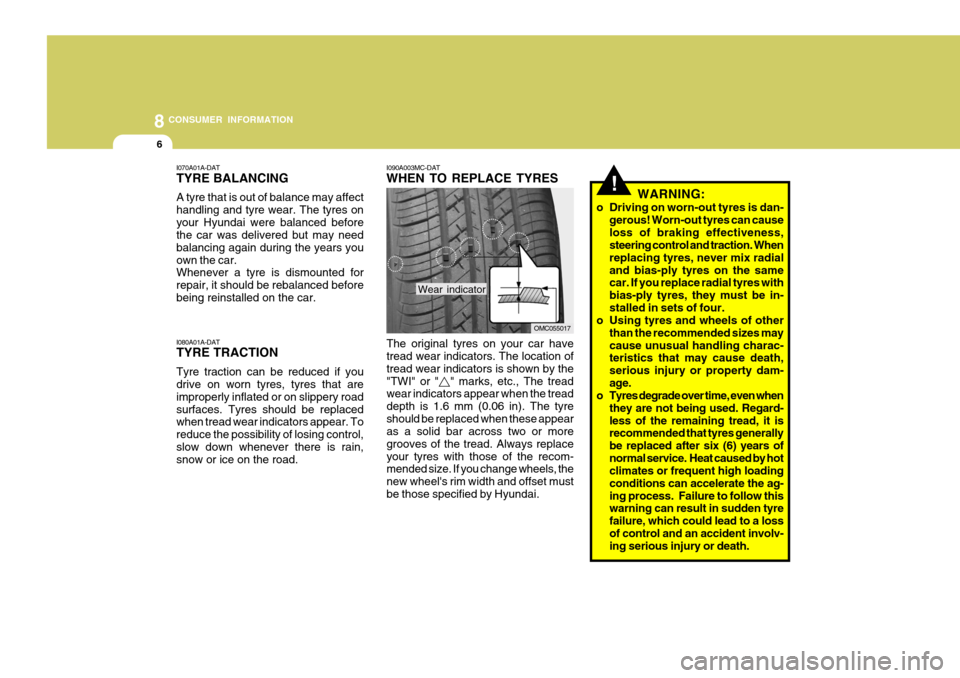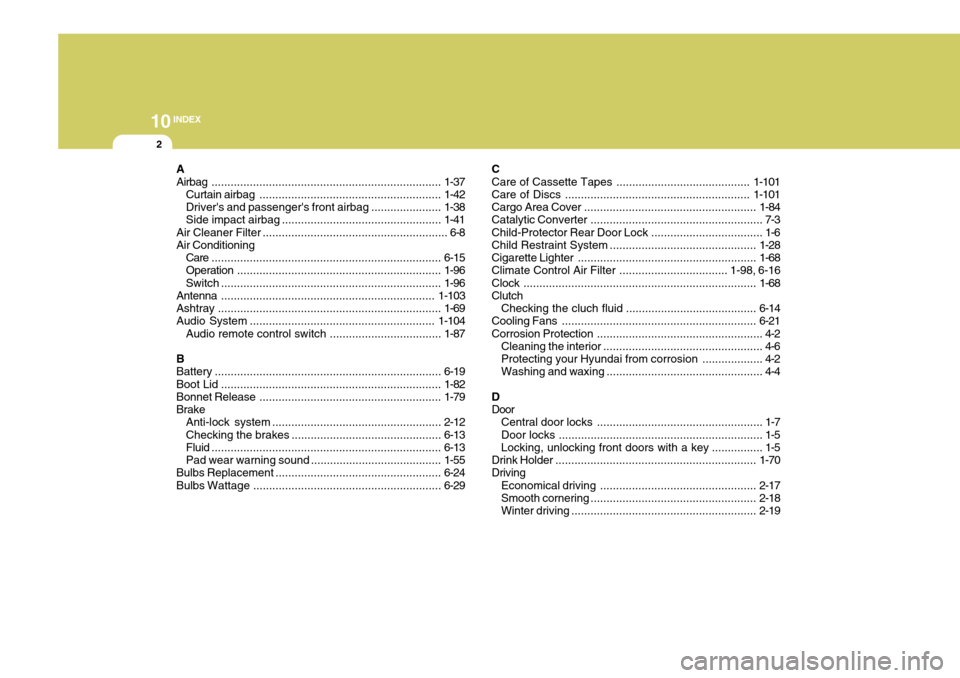2009 Hyundai Accent air condition
[x] Cancel search: air conditionPage 196 of 232

6
DO-IT-YOURSELF MAINTENANCE
15AIR CONDITIONING CARE
G140C01A-AAT Lubrication To lubricate the compressor and the seals in the system, the air condition-ing should be run for at least 10 min- utes each week. This is particularly important during cool weather whenthe air conditioning system is not oth- erwise in use.
G140A01A-DAT Keeping the Condenser Clean The air conditioning condenser (and engine radiator) should be checked periodically for accumulation of dirt, dead insects, leaves, etc. These caninterfere with maximum cooling effi- ciency. When removing such accumu- lations, brush or hose them away care-fully to avoid bending the cooling fans. Replacement of the filter drier To comply with local Australian State codes and Laws the filter drier must be replaced if the system has been openedto the atmosphere for any reason or if
during servicing no refrigerant is found in the system.
!
G140B01A-AAT Checking the Air Conditioning Operation
1. Start the engine and let it run at fast
idle for several minutes with the air conditioning set at the maximum cold setting.
2. If the air coming out of the in-dash
vents is not cold, have the air condi-tioning system inspected by your Hyundai dealer.
CAUTION:
Running the air conditioning systemfor extended periods of time with a low refrigerant level may damage the compressor.
Page 202 of 232

6
DO-IT-YOURSELF MAINTENANCE
21
!
G220B01A-AAT Checking Engine Cooling Fan The engine coolant fan should come on automatically if the engine coolanttemperature is high. G220C01TB-GAT Checking Condenser Cooling Fan When the air conditioning is in opera- tion, the condenser cooling fan comeson automatically, being controlled by
the engine ECU.
WARNING:
The cooling fan is controlled by engine coolant temperature and may sometimes operate even when the engine is not running. Use extremecaution when working near the blades of the coolant fan, so that you are not injured by a rotating fanblade. As the engine coolant temper- ature decreases the fan will automat- ically shut off. This is a normal con-dition. The power steering fluid level should be checked regularly. To check the power steering fluid level,be sure the ignition is "OFF", then check to make certain that the power steering fluid level is between the "MAX"and "MIN" level markings on the fluid reservoir.
CHECKING ELECTRIC COOLING FANS
G220A01A-AATPOWER STEERING FLUID LEVEL
G230A01MC-GAT
OMC055014
Page 220 of 232

8CONSUMER INFORMATION
4
These pressures were chosen to pro- vide the most satisfactory combination of ride comfort, tyre wear and stability under normal conditions. Tyre pressuresshould be checked at least monthly. CAUTION:
Always observe the following:
o Check pressures when the tyres are cold. That is, after the car has been parked for at least three hoursand hasn't been driven more than 1.6 km or one mile since starting up.
o Check the pressure of your spare tyre each time you check the pres-sure of other tyres.
o Worn, old tyres can cause acci-
dents. If your tread is badly worn, or if your tyres have been dam-aged, replace them.
! I040A02S-DAT SNOW TYRES If you equip your car with snow tyres, they should be the same size and havethe same load capacity as the original tyres. Snow tyres should be installed on all four wheels; otherwise, poor han-dling may result. Snow tyres should carry 28 kPa (4 psi) more air pressure than the pressurerecommended for the standard tyres on the tyre label on the driver's side of the centre pillar outer panel, or up to themaximum pressure shown on the tyre sidewall, whichever is less. Do not drive faster than 120 km/h (75mph) when your car is equipped with snow tyres.
OMC059101R
OMC059100RProper tyre inflation pressures should be maintained for these reasons:
o Lower-than-recommended tyre pres-
sures cause uneven tread wear and poor handling.
o Higher-than-recommended tyre pres-
sures increase the chance of dam-age from impacts and cause uneven tread wear.
4DOOR 3DOOR
Page 222 of 232

8CONSUMER INFORMATION
6
!
I090A003MC-DAT WHEN TO REPLACE TYRES
The original tyres on your car have tread wear indicators. The location of tread wear indicators is shown by the"TWI" or "
" marks, etc., The tread
wear indicators appear when the tread depth is 1.6 mm (0.06 in). The tyreshould be replaced when these appear as a solid bar across two or more grooves of the tread. Always replaceyour tyres with those of the recom- mended size. If you change wheels, the new wheel's rim width and offset mustbe those specified by Hyundai. WARNING:
o Driving on worn-out tyres is dan- gerous! Worn-out tyres can causeloss of braking effectiveness, steering control and traction. When replacing tyres, never mix radialand bias-ply tyres on the same car. If you replace radial tyres with bias-ply tyres, they must be in-stalled in sets of four.
o Using tyres and wheels of other
than the recommended sizes maycause unusual handling charac- teristics that may cause death, serious injury or property dam-age.
o Tyres degrade over time, even when
they are not being used. Regard-less of the remaining tread, it is recommended that tyres generally be replaced after six (6) years ofnormal service. Heat caused by hot climates or frequent high loading conditions can accelerate the ag-ing process. Failure to follow this warning can result in sudden tyre failure, which could lead to a lossof control and an accident involv- ing serious injury or death.
OMC055017
Wear indicator
I070A01A-DAT TYRE BALANCING A tyre that is out of balance may affect handling and tyre wear. The tyres onyour Hyundai were balanced before the car was delivered but may need balancing again during the years youown the car. Whenever a tyre is dismounted for repair, it should be rebalanced beforebeing reinstalled on the car. I080A01A-DAT TYRE TRACTION Tyre traction can be reduced if you drive on worn tyres, tyres that are improperly inflated or on slippery roadsurfaces. Tyres should be replaced when tread wear indicators appear. To reduce the possibility of losing control,slow down whenever there is rain, snow or ice on the road.
Page 229 of 232

10INDEX
2
A Airbag ........................................................................ 1-37
Curtain airbag ......................................................... 1-42
Driver's and passenger's front airbag ...................... 1-38
Side impact airbag .................................................. 1-41
Air Cleaner Filter .......................................................... 6-8
Air Conditioning
Care ........................................................................ 6-15
Operation ................................................................ 1-96
Switch ..................................................................... 1-96
Antenna ................................................................... 1-103
Ashtray ...................................................................... 1-69
Audio System .......................................................... 1-104
Audio remote control switch ................................... 1-87
B Battery ....................................................................... 6-19
Boot Lid ..................................................................... 1-82
Bonnet Release ......................................................... 1-79
Brake Anti-lock system ..................................................... 2-12
Checking the brakes ............................................... 6-13
Fluid ........................................................................ 6-13
Pad wear warning sound ......................................... 1-55
Bulbs Replacem ent .................................................... 6-24
Bulbs W attage ........................................................... 6-29C
Care of Cassette Tapes ..........................................
1-101
Care of Discs .......................................................... 1-101
Cargo Area Cover ...................................................... 1-84
Catalytic Converter ...................................................... 7-3
Child-Protector Rear Door Lock ................................... 1-6
Child Restraint System .............................................. 1-28
Cigarette Lighter ........................................................ 1-68
Climate Control Air Filter .................................. 1-98, 6-16
Clock ......................................................................... 1-68
Clutch
Checking the cluch fluid ......................................... 6-14
Cooling Fans ............................................................. 6-21
Corrosion Protection .................................................... 4-2
Cleaning the interior .................................................. 4-6
Protecting your Hyundai from corrosion ................... 4-2
Washing and waxing ................................................. 4-4
DDoor Central door locks .................................................... 1-7
Door locks ................................................................ 1-5 Locking, unlocking front doors with a key ................ 1-5
Drink Holder ............................................................... 1-70
Driving
Economical driving ................................................. 2-17
Smooth corneri ng .................................................... 2-18
Winter driving .......................................................... 2-19